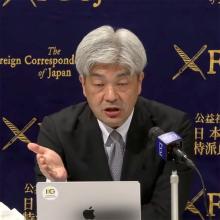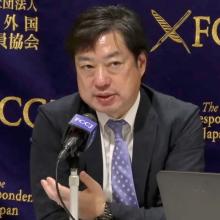Issue:
June 2025
Japan-U.S. ties have transformed since the war … and under Trump they are changing again, FCCJ event hears

“The most important bilateral relationship, bar none.” That is how former U.S. Ambassador to Japan Mike Mansfield described Washington-Tokyo ties in the 1980s. But the countries’ friendship in 2025 is much harder to evaluate.
Prime Minister Shigeru Ishiba and President Donald Trump will meet in June for their second bilateral in four months. In that time, Japan, along with most of Washington’s allies, has seen its trade position come under exacting scrutiny, pushing the leaders’ February “grip and grin” moment into the diplomatic rearview mirror.
Ishiba says he and Trump pledged to hold “productive” trade talks on the sidelines of the G7 meeting in Kananaskis, Canada, from June 15 to 17, saying it would be a bilateral “milestone”. However, Japan contends that it is inappropriate to use tariffs to address trade imbalances.
The U.S. has targeted Japanese auto, steel, and aluminum makers, while Tokyo faces a country-specific “reciprocal” hit.
How this trade drama plays out will be critical in assessing the strength of the nations’ bonds over the next four years and – more immediately – whether Ishiba goes into a summer upper house elections regarded as Trump savvy or Trump supplicate.
Who is going to blink first?

“Trump has a standing strongly overconfident about the power of the United States,” Professor Kazuto Suzuki of the University of Tokyo, said during an appearance at the FCCJ in May. “The U.S. capability in manufacturing is very much limited … At a certain point, Trump has to concede the enormous size of the tariffs.”
Suzuki predicted Japan would likely give in – to a degree – on auto tariffs. “Automobiles are the center of the negotiations,” he said. “Japan demands reducing or diminishing the entire tariff … which is rather difficult.”
“What is most important is the size of the quota. Japanese (car) exports to the U.S. are twenty times bigger than the U.K,” Suzuki added, noting Washington’s trade deal with London. “It is possible to have a quota in the 25% framework. The size of the quota can be negotiable. It is important to provide certain concessions for the U.S.”
The Nikkei Keizai Shimbun reported that Japan may water down its demands and call instead for tariffs to be reduced rather than eliminated. Its counter-proposal could also include increased imports of U.S. corn and soybeans, technical cooperation in shipbuilding, and revising inspection standards for imported autos. The two sides have also discussed joint gas development in Alaska, which would help the U.S. reduce its trade deficit through exports.
Nonetheless, Suzuki predicted a long game of bilateral “chicken” ahead. “I don’t think there will be any firm agreement on details of implementation of the tariffs by June 9,” he said. “This will be a sort of endurance game as to who will break first.”
Japan’s exports to the U.S. fell 1.8% in April, the first decline since December, but its trade surplus still rose 14.3% to ¥780.6 billion, the fourth straight increase. Japanese finance ministry officials and their U.S. Treasury counterparts, however, agreed in May that the dollar-yen rate - which has declined since the new Trump administration - actually reflected current economic fundamentals.
Separately, Nippon Steel and U.S. Steel agreed in May to enter a “partnership” that, according to the Trump administration, will create 70,000 jobs and add $14 billion to the U.S. economy. The deal, which the then president, Joe Biden, had blocked in January, reportedly guarantees that the firm will have an American CEO and a majority of U.S. board members, as well as a “golden share” requiring U.S. government approval of corporate activity.
Jesper Koll, expert director at Monex Group, said that financial market turmoil had prompted the U.S. to be more pragmatic.
“A sense of rationality actually started to come through with the first of the (U.S.) trade deals,” Koll said at the FCCJ. “The Trump team for all intents and purposes wants to raise the efficiency of the global financial architecture … of multilateral agreements.”
Looking at bilateral defense, a recent Asahi Shimbun survey found that only 15% of Japanese believed the U.S. would protect Japan in a military emergency, while 77% did not. Japan’s defense expenditures from fiscal 2023 are expected to jump by 50%, while the nation has made overtures to expand ties beyond the U.S. to Northeast and Southeast Asian countries.
Japan’s Defense Minister Gen Nakatani shared a new “one theater” approach with U.S. Defense Secretary Pete Hegseth in late March. The plan sees the East China Sea, the South China Sea, Korean Peninsula, and surrounding areas as a single theater in wartime.
According to Kyodo News, Nakatani said the sides had “confirmed a resolution to move forward with a sense of urgency,” while Hegseth was even more direct in regard to China.
The U.S. stands with Japan “in the face of aggressive and coercive actions by the communist Chinese", he said, adding the sides had not directly discussed Tokyo’s defense spending.

Professor Ken Jimbo of Keio University said Japan was pursuing an approach to defense that combined collaboration with competition.
“Strategic trust has widely eroded,” Jimbo said. “For Japan the question is no longer whether to engage but how to shape this turbulence into navigable order.
“Japan is no longer (just) defending territory, it is defending our own way of how the Asia-Pacific should be shaped.”
According to Jimbo, the military buildup in China, North Korea, and Russia has altered Japan’s preparations for potential threats – hence its multilateral “one-theater” defense plan. That said, the plan is a work in progress, he added.
“My colleagues at the Ministry of Defense and others don’t seem to have a conceptual definition,” Jimbo said. “I don’t think the Japanese government has become sophisticated enough in developing this idea, but it is not really the time to deny this atmosphere. It is about developing multilateral (defense) coordination among like minds.”
Dan Sloan is president of the FCCJ.

